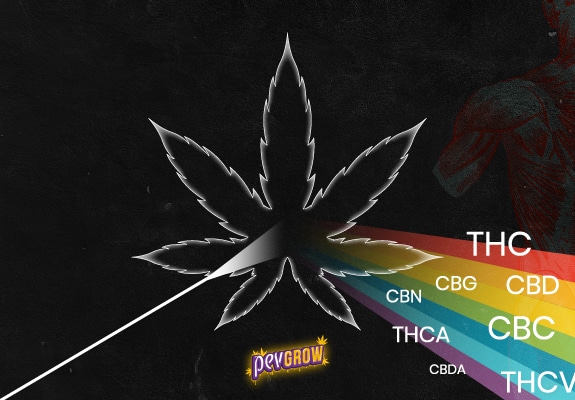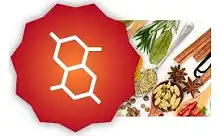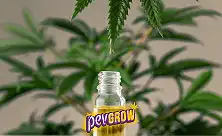- HHC vs Delta 8: Two distinct cannabinoids with many similarities
- Learn about cannabinoid hyperemesis syndrome


02-10-2024 07:00:33 - Updated: 2 October, 2024
The interest in cannabis has grown exponentially in recent years, largely due to research on cannabinoids, the chemical compounds present in this plant that interact with our body to produce a variety of effects. While some of these compounds, such as THC or CBD, are well-known, there are over 100 identified cannabinoids that are revolutionizing the way we understand health, wellness, and medicine.
In this article, we break down everything you need to know about cannabinoids: what are they?, how many types are there?, how do they work in our body? and what therapeutic benefits do they offer?
⛳ What are cannabinoids?
Cannabinoids are chemical compounds found in the cannabis plant and are also produced by our body. These compounds interact with the endocannabinoid system, a network of receptors distributed throughout our body that regulates essential functions such as mood, appetite, sleep, memory, and pain response.
There are two main types of cannabinoids:
- Phytocannabinoids: These are found in cannabis plants. The most well-known are THC (tetrahydrocannabinol) and CBD (cannabidiol), but there are many others, such as CBN, CBG, and CBC.
- Endocannabinoids: These are produced naturally by our body to regulate various physiological functions. The two most studied are anandamide and 2-AG (2-arachidonoylglycerol).
⭐ Most common types of cannabinoids
Although THC and CBD often receive all the attention, there are many more cannabinoids with interesting properties. Below, we present the most important ones:
1. THC (Tetrahydrocannabinol)
THC is the most well-known cannabinoid for being the main psychoactive compound in cannabis. It is responsible for the “high” that many people associate with weed consumption. It works by binding to the CB1 receptors of the endocannabinoid system, which are primarily in the brain, producing effects such as:
- Euphoria: A feeling of well-being or happiness.
- Altered sensory perception: Changes in the perception of time, colors, or sounds.
- Increased appetite: Commonly known as “the munchies.”
- Pain relief: THC is often used to treat chronic pain.
However, it can also have side effects such as anxiety, paranoia, or tachycardia, especially at high doses. If you want to delve deeper into this, check out this article explaining what THC is.
2. CBD (Cannabidiol)
CBD is another very popular cannabinoid, known for its therapeutic effects without psychoactive properties. This means it does not get you high or alter perception. It has been extensively researched for its ability to:
- Reduce anxiety and stress: Often used as a natural alternative to anxiolytics.
- Relieve pain and inflammation: Very effective in cases of arthritis and chronic pain.
- Treat neurological disorders: Such as epilepsy, with Epidiolex being an approved medication based on CBD.
- Improve sleep: Especially useful for those suffering from anxiety-related insomnia.
Additionally, CBD has a neuroprotective effect, meaning it could be useful for treating diseases like Alzheimer’s or Parkinson’s. cannabidiol is the cannabinoid with the most therapeutic properties, and if you want to know it better, you can’t miss this article titled What is CBD?
3. CBN (Cannabinol)
CBN is a cannabinoid that forms when THC breaks down over time or when exposed to heat. Although it is not psychoactive, it has sedative effects, so it is often used to treat insomnia. Some studies also suggest that CBN may have anti-inflammatory properties and be useful for treating chronic pain. Follow this link if you want to see a complete article discussing the CBN cannabinoid.
4. CBG (Cannabigerol)
CBG is known as the “mother cannabinoid” because both THC and CBD are synthesized from CBGA (cannabigerolic acid), its acidic form. Although it is present in small amounts in the cannabis plant, CBG has shown promising effects such as:
- Antibacterial: It may be useful in fighting antibiotic-resistant infections.
- Neuroprotective: Similar to CBD, it may protect the nervous system.
- Appetite stimulant: It has been researched as a potential treatment for appetite disorders.
If you are curious and want to read more about cannabigerol, I recommend reading this article that explains in depth what CBG is.
5. CBC (Cannabichromene)
CBC is another non-psychoactive cannabinoid that has shown anti-inflammatory and analgesic effects. Additionally, it is believed to enhance the effects of other cannabinoids in what is known as the entourage effect, where various compounds from cannabis work together to increase their efficacy. This cannabinoid is less known than the previous ones, but it has shown that it can be very interesting in the future for its medicinal properties, and if you want to know it thoroughly, click here to see what CBC is and what its benefits are.
✨ The endocannabinoid system: The key to how cannabinoids work
The endocannabinoid system (ECS) is a network of receptors found throughout our body that plays a crucial role in regulating physiological and cognitive processes. This system is composed of two main types of receptors:
- CB1 Receptors: Mainly located in the brain and central nervous system, CB1 receptors are responsible for the psychoactive effects of THC and play a key role in regulating mood, appetite, and memory.
- CB2 Receptors: Found in the immune and peripheral system. These receptors are more involved in regulating inflammation and immune response.
When cannabinoids, whether plant-derived or produced by our body, interact with these receptors, they help maintain balance in various bodily processes, such as pain control, inflammation, and appetite.
👌 Synthetic cannabinoids: What are they and why are they so controversial?
Synthetic cannabinoids are chemical compounds created in laboratories that mimic the effects of natural cannabinoids found in the cannabis plant, such as THC or CBD. Although they were initially designed for scientific and medical purposes, some of them have been used in illegal recreational products, raising concerns due to their potent effects and health risks. Synthetic marijuana can be much more dangerous than natural cannabis, and it is also much more addictive, and at Pevgrow we advise all our readers to be well-informed before trying certain synthetic cannabinoids.
How do synthetic cannabinoids work?
Like natural cannabinoids, synthetic ones also interact with the body’s endocannabinoid system. However, their interaction can be much more intense. While THC binds to the brain’s CB1 receptors moderately, synthetic cannabinoids often have a much higher affinity for these receptors, resulting in more potent and often unpredictable effects. This high potency increases the risk of severe and potentially dangerous side effects.
Origin and development
Synthetic cannabinoids were originally developed for scientific research purposes, to better study the endocannabinoid system and its potential therapeutic applications. Compounds such as HU-210, CP-55940, and WIN-55,212-2 were created to investigate pain relief, neuroprotection, and anti-inflammatory effects.
Later, some of these synthetic cannabinoids became approved medical treatments, such as nabilone and Marinol (dronabinol), which are used to treat chronic pain, nausea, and vomiting associated with chemotherapy or appetite loss in patients with HIV/AIDS.
Illegal synthetic cannabinoids: the case of “Spice” and “K2”
In the last decade, some clandestine laboratories began manufacturing illegal synthetic cannabinoids, such as JWH-018 and AM-2201, for recreational use. These products were sold under brand names like “Spice” or “K2,” and were presented as “legal” alternatives to cannabis. However, these products turned out to be highly dangerous, causing severe reactions such as hallucinations, paranoia, seizures, and in some cases, deaths.
These illegal synthetic cannabinoids are much more potent than natural THC and do not contain the protective compounds present in cannabis, such as terpenes or flavonoids, which help moderate the effects. This makes them particularly dangerous, as doses can be difficult to control, and adverse effects are unpredictable.
🚀 Benefits and risks of synthetic cannabinoids
Benefits:
- Medical research: Many synthetic cannabinoids are used in scientific studies to better understand the endocannabinoid system and its role in human health.
- Therapeutic applications: Compounds like nabilone and dronabinol are approved to treat serious diseases such as cancer or HIV/AIDS, helping to control pain, nausea, and appetite loss.
Risks:
- Toxicity: Illegal synthetic cannabinoids have a much higher potency than THC, which can lead to overdoses and severe toxic effects.
- Severe side effects: These include hallucinations, tachycardia, seizures, kidney damage, and even psychosis or violent behavior.
- Legality: In many countries, the use and distribution of synthetic cannabinoids are prohibited, but the rapid evolution of new formulas makes regulation difficult.
🔥 Table of natural and synthetic cannabinoids
| Cannabinoid | Type | Origin | Psychoactive | Therapeutic Benefits | Main Uses |
|---|---|---|---|---|---|
| THC (Delta-9) | Natural | Cannabis (weed) | Yes | Pain relief, appetite stimulation, relaxation, anti-inflammatory | Chronic pain, insomnia, appetite loss, anxiety |
| CBD (Cannabidiol) | Natural | Cannabis (hemp and weed) | No | Anxiety, pain relief, anti-inflammatory, neuroprotective, anticonvulsant | Epilepsy, anxiety, arthritis, general well-being |
| CBN (Cannabinol) | Natural | Degradation of THC | Mild | Sedative effects, pain relief, antibacterial properties | Insomnia, chronic pain, bacterial infections |
| CBG (Cannabigerol) | Natural | Cannabis (mainly hemp) | No | Anti-inflammatory, neuroprotective, antibacterial, appetite stimulant | Inflammatory diseases, neurodegenerative diseases |
| CBC (Cannabichromene) | Natural | Cannabis | No | Anti-inflammatory, analgesic, stimulates anandamide production | Pain, inflammation, potential neuroprotective |
| THCV (Tetrahydrocannabivarin) | Natural | Cannabis | Yes, but weak | Appetite suppressant, blood sugar regulator, possible neuroprotective | Appetite control, metabolic diseases, diabetes |
| Delta-8 THC | Natural | Cannabis (lesser amount) | Yes | Pain relief, anxiolytic, appetite stimulant | Anxiety, chronic pain, nausea, appetite loss |
| Delta-10 THC | Natural | Cannabis (rare) | Yes, milder than Delta-9 | Stimulant, less anxiety than Delta-9 THC | Recreational, mild pain relief |
| HU-210 | Synthetic | Laboratory | Yes | Pain relief, anti-inflammatory, anxiolytic | Medical research, pain relief |
| JWH-018 | Synthetic | Laboratory | Yes | Potent, used in scientific research and synthetic recreational products | Used in illegal synthetic cannabinoids (Spice) |
| Nabilone | Synthetic | Laboratory | Yes | Antiemetic, analgesic | Nausea and vomiting induced by chemotherapy, chronic pain |
| Marinol (Dronabinol) | Synthetic | Laboratory (derived from THC) | Yes | Appetite stimulant, antiemetic, pain relief | Treatment of HIV/AIDS, nausea from chemotherapy |
| Epidiolex (Cannabidiol) | Synthetic (natural derivative) | Laboratory | No | Anticonvulsant, neuroprotective | Epilepsy (Lennox-Gastaut and Dravet syndromes) |
| CP-55940 | Synthetic | Laboratory | Yes | Analgesic, anti-inflammatory, neuroprotective | Scientific research, model for cannabinoid studies |
| WIN-55,212-2 | Synthetic | Laboratory | Yes | Anti-inflammatory, neuroprotective, analgesic | Medical research, model for ECS studies |
| AB-FUBINACA | Synthetic | Laboratory | Yes | Potent, used in synthetic drug products (recreational) | Illegal synthetic recreational products |
| AM-2201 | Synthetic | Laboratory | Yes | Potent psychoactive, recreational | Illegal synthetic recreational products |
| THC-O (THC Acetate) | Synthetic | Laboratory (derived from THC) | Yes | Analgesic, antiemetic, potent psychoactive | Medical research, recreational |
🥇 Explanation of the table:
Natural: Cannabinoids such as THC, CBD, CBN, and others are found naturally in the cannabis plant. These are the most well-known and used for their multiple therapeutic and recreational benefits.
Synthetic: Synthetic cannabinoids, such as HU-210, JWH-018, and Nabilone, were created in laboratories for scientific studies or medical treatments. Some of them, like Marinol, are approved for therapeutic use in treating nausea or appetite loss. However, others like JWH-018 are used in illegal recreational products and are much more dangerous due to their potency and unpredictable side effects.
📱 Main Differences between Natural and Synthetic Cannabinoids
Natural Cannabinoids: They are derived from the cannabis plant, and their interaction with the endocannabinoid system is better understood. Their effects are usually milder and more predictable, with a more known safety profile.
Synthetic Cannabinoids: Some of these compounds were created to mimic or enhance the effects of natural cannabinoids, but due to their high potency, they can have severe side effects. Illegal synthetic cannabinoids, such as those used in products like “Spice” or “K2,” are known to cause dangerous adverse reactions.
🌞 Other cannabinoids
In addition to natural and synthetic cannabinoids, there are also others that could be considered a mix of both, as they are semi-synthetic cannabinoids. I don’t want to get too deep into this topic, but I will tell you that although they can be found naturally in some cannabis strains, these cannabinoids are usually manufactured in the laboratory, in processes like hydrogenation that incorporates hydrogen atoms into molecules like THC or CBD. Among the most well-known semi-synthetic cannabinoids are H4CBD, HHC, or HHC-O among many others.
👾 Understanding the “entourage effect”
The “entourage effect” is a phenomenon that occurs when several cannabinoids and terpenes work together to enhance their effects. This means that consuming a cannabis plant in its full form, with all its compounds, can be more effective than consuming an isolated cannabinoid. For example, it is believed that CBD can reduce the side effects of THC, such as anxiety or paranoia, while together they can offer better pain relief.
🎯 Therapeutic uses of cannabinoids
Cannabinoids, especially THC and CBD, have a wide variety of therapeutic uses. Here are some of the most common and well-documented applications:
- Chronic pain relief: THC and CBD have been shown to be effective in treating chronic pain, especially in people with conditions such as arthritis, fibromyalgia, and neuropathic pain. Both cannabinoids interact with the endocannabinoid system to reduce pain signaling and decrease inflammation.
- Treatment of epilepsy: CBD has been extensively studied as a treatment for severe forms of epilepsy, such as Dravet Syndrome and Lennox-Gastaut Syndrome, which do not respond well to conventional treatments. The medication Epidiolex, based on CBD, has been approved by the FDA for the treatment of these conditions. On the other hand, CBD oil is one of the trending medications thanks to its multiple benefits. In our CBD shop, we offer cannabidiol oil and other products that can be consumed through vaporization, smoking, topically, and other forms.
- Control of anxiety and stress: One of the most popular uses of CBD is its ability to reduce anxiety and stress. Unlike THC, which can increase anxiety in some people, CBD has a calming effect that is ideal for those suffering from generalized anxiety disorder, panic disorder, or insomnia.
- Appetite enhancement: THC is well known for its ability to stimulate appetite, making it an effective treatment for people suffering from diseases that cause weight loss, such as HIV/AIDS or certain types of cancer.
- Neuroprotection: Both CBD and CBG have shown neuroprotective properties, meaning they can help protect the brain and nervous system from damage. This is particularly important in neurodegenerative diseases such as Alzheimer’s, Parkinson’s, or multiple sclerosis.
✅ Are there risks in consuming cannabinoids?
Although cannabinoids offer many benefits, they can also have side effects, especially when consumed in high doses. Some of the most common side effects include:
- Dry mouth and dry eyes: Especially common with THC.
- Anxiety or paranoia: THC can increase anxiety in some people, especially at high doses.
- Fatigue or drowsiness: CBD and CBN can cause sedation in some people.
- Increased heart rate: THC can cause tachycardia, which can be concerning for people with heart problems.
It is important to remember that dosing and individual tolerance play a crucial role in how cannabinoids affect each person. It is always advisable to start with low doses and adjust as necessary.
❤️ Editor’s opinion
Cannabinoids are an exciting field in medical science and wellness. From my perspective, the greatest value of these compounds lies in their versatility and how they can be tailored to treat a variety of conditions, from chronic pain to neurological disorders. Additionally, the fact that CBD, in particular, does not cause psychoactive effects makes it an accessible and safe option for many people. Now that we know the specific properties of many cannabinoids, as well as the modulation of their effect by combining with terpenes, I am sure that in the coming years we will see all kinds of medications based on these compounds appear on the market, and that will make life easier for many people.
🦋 Conclusion
Cannabinoids are powerful chemical compounds that have the potential to transform the way we treat a wide range of medical conditions. From THC and its ability to relieve pain and increase appetite, to CBD, with its calming and therapeutic effects without psychoactivity, these compounds offer solutions for both daily wellness and the treatment of serious illnesses. While there is still much to discover, cannabinoids have already proven to be an essential part of modern medicine and self-care.
🔰 Frequently Asked Questions (FAQ)
How do cannabinoids work?
Cannabinoids interact with the endocannabinoid system (ECS), a network of receptors found throughout the body, including the brain, organs, and immune system. The CB1 and CB2 receptors are the main ones in this system. CB1 receptors are primarily in the brain and are responsible for the psychoactive effects (such as those produced by THC). CB2 receptors are found in greater numbers in the immune system and are key in regulating inflammation and pain. Cannabinoids bind to or modulate these receptors to help regulate functions such as pain, appetite, sleep, and mood.
What are cannabinoid terpenes?
Terpenes are aromatic compounds found in cannabis plants and other plant species. Although they are not cannabinoids, they interact with them in what is known as the entourage effect, enhancing and modulating the therapeutic and psychoactive effects of cannabinoids like THC and CBD. Each terpene has its own effects; for example, myrcene is relaxing, while limonene can improve mood. The combination of terpenes and cannabinoids can influence the overall consumption experience.
Do cannabinoids lower blood pressure?
Some studies suggest that certain cannabinoids, especially CBD, may help lower blood pressure in stressful situations. CBD has relaxing and anxiolytic properties that can decrease heart rate and blood pressure. However, THC, at high doses, can temporarily increase heart rate, which may elevate blood pressure in some users. It is important to consult a doctor before using cannabinoids if you have cardiovascular issues.
Do cannabinoids kill cancer cells?
Some preliminary studies in the lab and in animals have shown that certain cannabinoids, such as THC and CBD, have the ability to induce cancer cell death (apoptosis) and slow tumor growth. However, this research is in early stages, and there is no conclusive evidence that cannabinoids can cure cancer in humans. Cannabinoids are used to help manage cancer symptoms, such as pain, nausea, and appetite loss, especially during chemotherapy.
How are synthetic cannabinoids made?
Synthetic cannabinoids are created in laboratories using chemical processes that mimic the structure and function of natural cannabinoids like THC or CBD. Scientists modify the chemical structure of cannabinoids to create more potent compounds or to investigate specific effects. These cannabinoids are not extracted from the cannabis plant but are synthesized from other chemicals. Some of these cannabinoids are used in medicine, while others have been produced for illegal recreational purposes, such as in products known as “Spice” or “K2”.
How many cannabinoids are there?
So far, over 100 cannabinoids have been identified in the cannabis plant. Some of the most well-known are THC, CBD, CBN (cannabinol), CBG (cannabigerol), and CBC (cannabichromene). Each of these cannabinoids has different effects and therapeutic properties. In addition to these natural cannabinoids, there are numerous synthetic cannabinoids created in laboratories for scientific research and medical treatments.
What do cannabinoids do in the body?
Cannabinoids regulate various physiological functions in the body through their interaction with the endocannabinoid system. Depending on the type of cannabinoid, they can help reduce pain, inflammation, anxiety, and nausea. They can also improve sleep, increase appetite, and regulate mood. Psychoactive cannabinoids, such as THC, alter perception and behavior, while others like CBD have therapeutic effects without altering mental state.
Which cannabinoids are psychoactive?
The main psychoactive cannabinoid is THC (tetrahydrocannabinol), which is responsible for the euphoric effects, altered perception, and “high” associated with weed consumption. Other cannabinoids, such as THCV and Delta-8 THC, are also psychoactive, although to a lesser extent than THC. On the other hand, cannabinoids like CBD, CBG, and CBC are not psychoactive, meaning they do not alter perception or produce “high” effects.
🚦 Sources:
Video in English:








After reading the article, I now understand what cannabinoids are and I have learned about all the types that exist; I prefer CBD but it’s good to know about the rest…